Build a content hub that fulfills audience needs, attracts new readers, and converts leads.
We’ve been blogging since the nineties. Content creators, SEO specialists, writing enthusiasts, and copywriting experts have flooded the Information Age with blogs to build genuine relationships with their audience.
A content hub is the rooftop bar to the sturdy foundations established by blogging. It’s an elevation of content. It's a more diverse and strategic framework than a standard blog page that gives your audience quality resources at every stage of their customer journey.
What is a content hub?
In essence, a content hub is a central place packed full of content dedicated to specific and relevant topics. We’re not just talking about written content; a content hub incorporates videos, podcasts, research, data visuals, courses, downloads, and more.
In essence, a content hub is a central place packed full of content dedicated to specific and relevant topics. We’re not just talking about written content; a content hub incorporates videos, podcasts, research, data visuals, courses, downloads, and more.
A well-designed content hub can be fundamental to building brand awareness, loyalty, and increasing organic traffic.
Which approach is right for you? Choose from these 4 types of content hubs
Your industry, your target audience, and how they prefer to encounter and absorb content will impact which type of content hub you should implement for your business.
The structure of your content hub should be built around your main topic, related subtopics, and keywords. Your content needs to include multiple formats, such as text, visual, and video components.
You’ll want your content to be featured in more than one location (ideally on other reputable websites), and your content creators should stretch beyond your internal creators—specifically to influencers who can direct more of your audience to your hub. This helps ensure that your content hub is findable in more places, increasing brand exposure and awareness.
The first step is deciding what type of content hub you want to build.
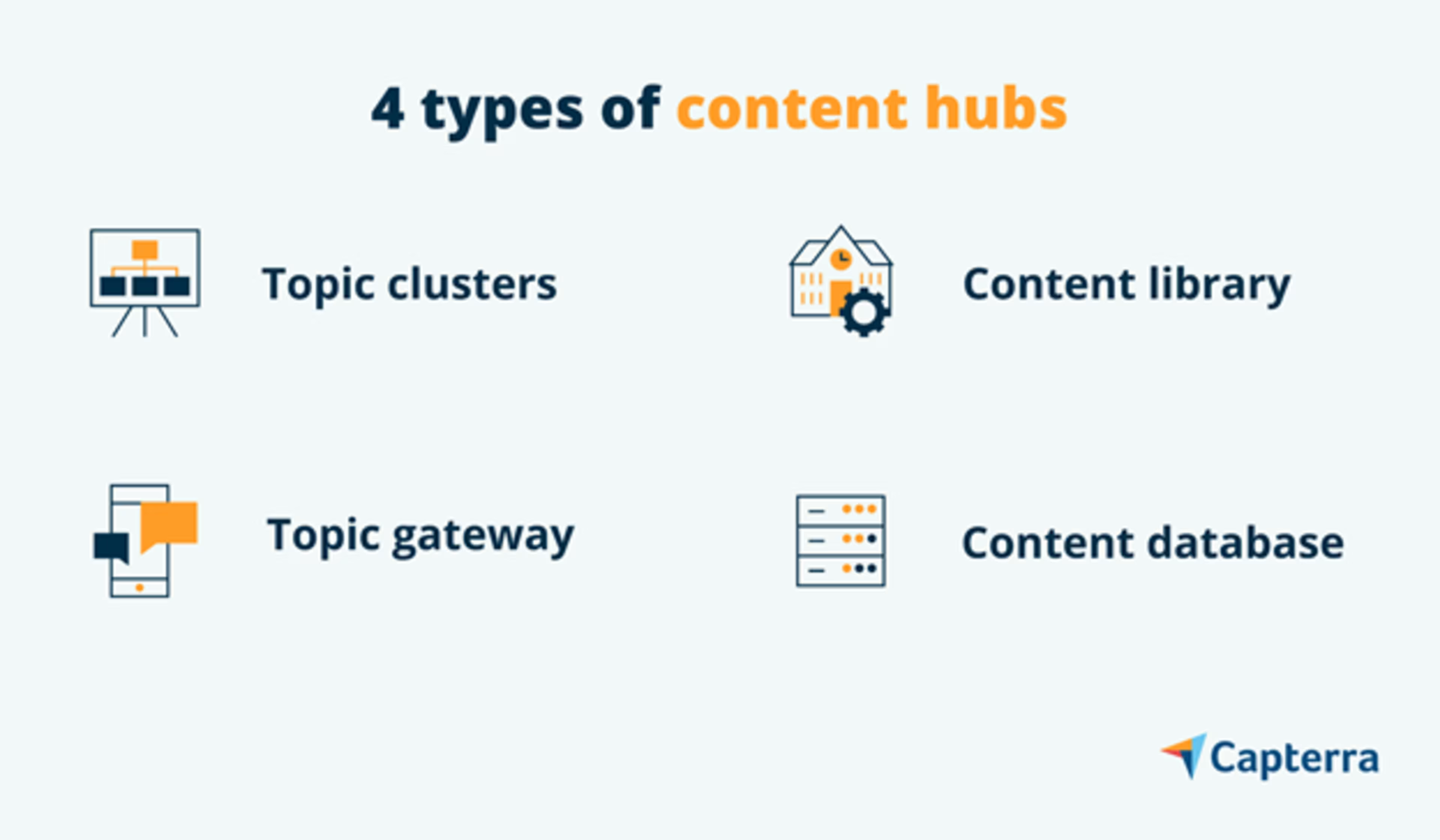
1. Topic clusters
This type of hub is based around a main topic page with a conglomerate of branching subtopics covering related items.
Topic clusters are effective when content is evergreen because they allow you to consistently add new content.
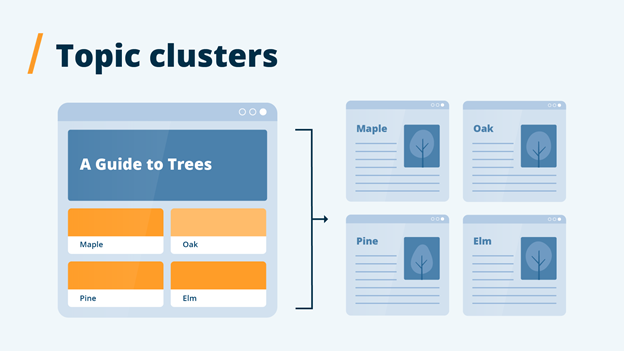
Example of topic clusters
2. Content library
This type of content hub includes a handy index page where the audience can easily source all topics and links. Each main topic links out to various other pages such as articles, whitepapers, or videos.
SEO teams, professionals, executives, and specialists often recommend a content library due to how easily accessible and clearly organized the landing pages are. All of these attributes make a content library more attractive to Google when it crawls your site, meaning the content has a better chance of being indexed.
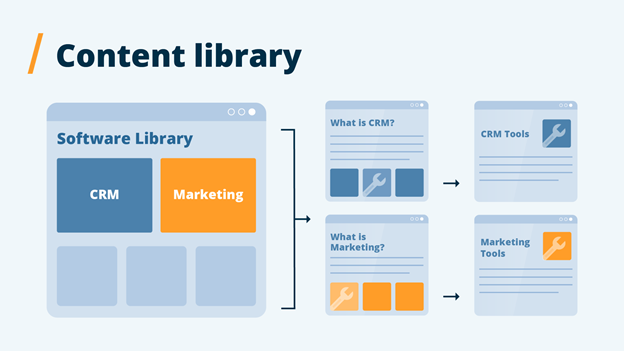
Example of a content library
3. Topic gateway
Topic gateways are unique because every topic gets its own landing page that offers an overview, links to further resources, and dynamically links to new content about the topic.
This variation of a content hub is particularly useful if your site has a large amount of content about different subjects. It's a great way to present content that is useful for all stages of awareness, either low-awareness visitors seeking learning opportunities or visitors looking to quickly find the latest content about a subject.
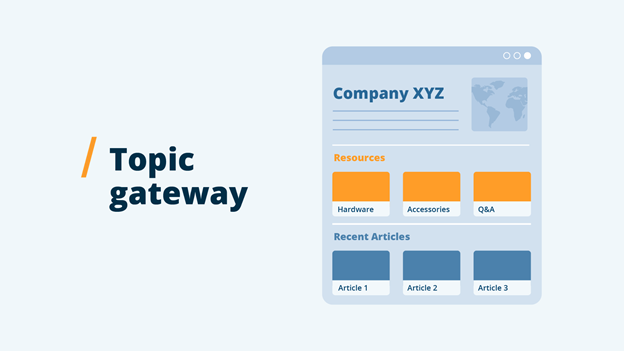
Example of a topic gateway
4. Content database
A content database is a better choice than a content library if you are organizing more than 1,000 pages. Both a content library and a content database are great for backlink generation, lead generation, and organic traffic to your content hub. A content database is on a much larger scale.
Have loads of brilliant information? Running a big brand? A content database is probably the most efficient way to set up an easy filtering system. You can give your audience the tools to focus on what they are most interested in by enabling quick sorting by topics, factors, or characteristics.
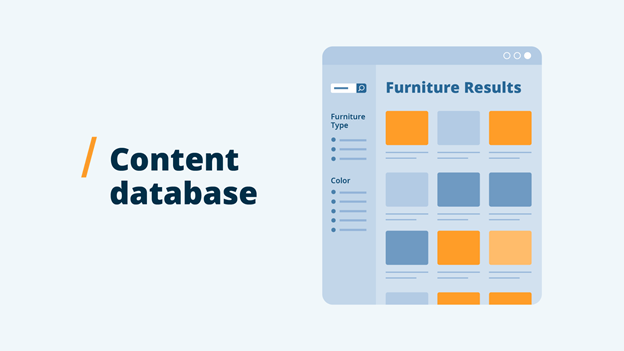
Example of a content database
The benefits of building and maintaining a content hub
Becoming a leader in your industry has all kinds of benefits, and a content hub that is relevant to your brand and trusted by your audience is a large part of establishing your leadership.
The benefits of investing in your content hub include organic traffic growth, strengthened brand positioning, establishing thought leadership, lead generation, and an optimized user experience. Let's take a look at each.
1. Organic traffic growth
Each individual piece of content that you create presents an opportunity to rank for target keywords. When your content is engaging, unique, and valuable to your audience, you rank higher on search engine results pages (SERPs), which helps boost your organic traffic.
The more traffic that lands on your content hub, the more people are exposed to your content and the higher your chance of a conversion.
2. Strengthened brand positioning
There is no point spotlighting a stage that your audience isn’t looking at. Your content hub helps ensure that your platform is in front of your audience with focused, tailored content.
The beauty of a rich content hub is that it shows off your brand while also giving your audience the time to get to know your business. Your hub should strive to solve as many of your audience’s problems as possible by answering questions and offering tools.
By consistently offering value, your business is positioning itself as a trustworthy source for your audience, which ultimately positively reflects on your brand.
3. Improved engagement and better relationships
If your audience is landing on your page and not engaging, then you aren’t quite on the winning streak you imagined.
When laid out properly, content hubs make it easy for your audience to have a guided, positive experience. With their journey signposted for them, visitors are more likely to click through and consume more content.
The longer they navigate around your content hub, the higher their engagement level and the more likely they are to establish a relationship touchpoint with your business.
4. Establish thought leadership
Business leaders with large followings are admired the world over in their areas of expertise. Thought leadership content is no different. Working to create a hub of valuable knowledge that is also a reflection of your business’ unique selling point is what will position you as a thought leader in your industry.
Developing your content to the thought leadership level invites more backlinks and increases brand mentions. This makes more people want to share your content, which, in turn, drives organic traffic, escalates clicks, and cements your brand’s position as a thought leader.
5. Lead generation
While your content hub should be focused on the needs of your customers, one of the biggest benefits is the natural lead generation it facilitates.
When your audience finds your hub and deems it as worthy of attention based on the information it provides, they will naturally spend more time there. This creates moments for action that you can capitalize on to capture leads that feed your funnel.
This can be done through the content hub with standard lead capturing, well-placed calls to action, and progressive profiling.
6. Optimized user experience
Your business means a lot to you, which is why creating a journey for your audience to learn from, engage with, and ultimately invest in your business is essential.
When you create a content hub, you’re telling your audience that you care about their interests, motivations, and intent. You are establishing an informational trove of everything they could possibly want to know about what you can offer them.
Great user experience feeds into retention, customer loyalty, referrals, and so much more.
Follow these 6 steps to build your strategic content hub
The benefits of a well-oiled content hub are clearly worth the effort, but how exactly do you go about establishing one?
1. Understand your audience
Your audience is who you need to speak to whenever you create content, and an essential part of that is knowing where they are in their awareness journey.
At the end of the day, you’re speaking to people, and knowing where they came from and what their goals are will help you reach them in a more authentic way. This means looking at demographics, behavior, and purchasing habits to determine what they are looking for.
Here are some tips to help you better understand your audience:
Create buyer personas
Monitor feedback
Conduct surveys
Review analytics for behavior patterns
2. Identify valuable topics
Topics make the difference between unique content that is worth reading and content that simply becomes part of the over-saturated internet. Creating solutions-centric content that meets your audience where they are is important, so make sure your hub is accessible.
This means creating content for those who are first encountering your business as well as those who know what they want but just need the research or information to back their decision.
Your topics should solve problems and be searchable. Make a list of problems, questions, answers, and SEO keywords before linking them together to create valuable content.
3. Choose a type of hub
Knowing who your customers are will help you decide which type of content hub to build. If your audience hangs out on TikTok, for example, there isn't much point to spending hours on your Instagram page. If they prefer video content, then blogs won’t hit the mark either.
4. Audit existing content and organize future content
Content audits are great for finding ways to improve your content, highlighting gaps, and pinpointing opportunities to optimize content that may be not as relevant as it used to be.
When developing a hub, it’s important that you review all content and continuously make it better so you’re ensuring the information you’re sharing is accurate and relevant for your audience.
Of course, you need content to audit, so if you don’t already have a bank of content, start building your hub. You should be auditing your content every 3-6 months. This will highlight gaps for optimization and areas where new content is needed.
5. Look at your competition to improve your content
Your competition should be a lighthouse on a stormy night; watch how their hubs are performing. Are they doing anything differently? What keywords are they ranking for? Could you target the same keywords?
Then make your content better than theirs. Collaborate with keyword research. Constantly improve on the best out there.
6. Analyze and optimize
Traffic and engagement data will show you what’s working and what isn’t. It’s also a wonderful source of information for you to rely on to help monitor user behavior, changes in organic traffic, bounce rate, and more.
Follow the data. It shows you the most honest version of what your audience is looking for and provides the insight necessary to create a content hub that evolves with your business.
Give your audience actionable insights with a strategic content hub
Remember to listen to feedback, focus on user experience, and keep a close eye on the data. This is what will set you apart from your competitors.
A content hub takes strategy, discipline, understanding, and quality content, but the rewards your business will reap make it worth the resource investment.
Developing content that speaks to your audience is the pivotal starting point for your business.
Establishing customer retention, satisfaction, and value is the next level up. Get the tools to build a relationship marketing strategy here.
Are you interested in becoming a guest writer for Capterra? Reach out to guestcontributors@gartner.com for details.
